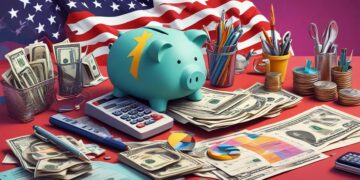How to Interpret the Main Economic Indicators of the USA

The Significance of Economic Indicators
Economic indicators serve as vital benchmarks for evaluating the stability and growth of an economy. They provide crucial insights that can guide both individual and corporate decision-making. Particularly in the United States, understanding these indicators enables people to gauge economic performance, forecast future developments, and make informed choices regarding investments, spending, and savings.
Let’s delve into some of the most significant economic indicators:
- Gross Domestic Product (GDP): This indicator represents the total market value of all goods and services produced in a country over a specific period, usually annually or quarterly. GDP is essential because it reflects the overall economic activity and health. For instance, if the GDP is rising, it suggests a growing economy, often leading to more job creation and increased consumer spending.
- Unemployment Rate: The unemployment rate measures the percentage of the total labor force that is unemployed but actively seeking work. A lower unemployment rate often indicates a healthy economy where jobs are plentiful. Conversely, a high rate may signal economic distress. For example, during the COVID-19 pandemic, the unemployment rate soared, highlighting significant economic challenges that affected many families and businesses across the nation.
- Inflation Rate: Inflation represents the rate at which the general level of prices for goods and services rises, eroding purchasing power. This is frequently measured using the Consumer Price Index (CPI). For instance, if the inflation rate is high, it means that you will need to spend more to purchase the same items as before. For many Americans, rising grocery and gas prices are clear reminders of how inflation impacts their everyday expenses.
- Consumer Confidence Index (CCI): This index gauges how optimistic or pessimistic consumers are about the economy and their personal financial situations. A high CCI often correlates with increased consumer spending, which is vital for economic growth. For instance, when consumers feel confident, they are more likely to make significant purchases, such as homes and cars, stimulating economic activity.
Recognizing the implications of these indicators extends beyond economists and financiers. Students, entrepreneurs, and everyday citizens can benefit from this knowledge. For example, understanding the unemployment rate may influence a graduate’s job search, as they might focus on sectors with lower unemployment rates. Similarly, by observing the inflation rate, a consumer might decide to stock up on essential items when prices are stable, ensuring they are prepared for future price hikes.
By familiarizing yourself with these key economic indicators, you empower yourself to make wiser financial decisions today and understand the broader economic landscape of tomorrow. In the following sections, we will break down how to interpret these indicators effectively, ensuring you stay informed and ready to navigate the economic environment.
SEE ALSO: Click here to read another article
Understanding and Interpreting GDP
One of the key indicators of economic health is the Gross Domestic Product (GDP). To interpret GDP effectively, it is important to understand not just its numerical value but also its implications on the economy. When the GDP is reported as growing, it signifies that more goods and services are being produced and consumed. For example, if the GDP increased from $20 trillion to $21 trillion over a year, it indicates overall economic expansion, which can lead to increased business investments and consumer spending.
However, GDP growth should be viewed in context. An economy can experience growth alongside rising inflation, thus masking the actual increase in purchasing power. For instance, if the GDP increased significantly during a period of high inflation, individuals may not feel richer, as their dollar buys less than before. Therefore, along with GDP, it is essential to examine the inflation rate to fully understand economic health.
Analyzing the Unemployment Rate
The unemployment rate serves as a critical gauge for understanding the job market’s vitality and overall economic conditions. It is calculated by dividing the number of unemployed individuals actively seeking work by the total labor force. For instance, an unemployment rate of 4% indicates a healthy job market, where most individuals can find employment. On the other hand, a rising unemployment rate can signal economic challenges and reduced consumer confidence. During economic downturns, such as the recession caused by the COVID-19 pandemic, the unemployment rate can spike dramatically, making it crucial for individuals and policymakers to monitor this indicator closely.
When scrutinizing the unemployment rate, consider its impact on different demographics. For example, if the overall unemployment rate is low, yet specific groups, such as recent college graduates or minorities, are experiencing higher unemployment, this information is essential for understanding underlying economic disparities. By examining these aspects, you can engage in more informed discussions about labor market trends and their implications for various segments of society.
Deciphering the Inflation Rate
The inflation rate is another pivotal economic indicator that affects consumers on a day-to-day basis. Although a moderate level of inflation is normal in a growing economy, excessive inflation can severely impact purchasing power. The Consumer Price Index (CPI) is commonly used to measure inflation, reflecting the average price changes of a basket of consumer goods and services. For example, if the CPI increases by 3% over the year, it reveals that the cost of living has risen, meaning that consumers will need to allocate more of their budgets toward the same necessities.
In contrast, deflation (a decline in the inflation rate) can also be problematic. It may signal an economic slowdown, as consumers may postpone purchases in anticipation of lower prices in the future. Identifying trends in inflation allows households to adjust their financial strategies. For example, if inflation is rising rapidly, individuals may consider investing in assets that traditionally perform well during inflationary periods, like real estate or commodities.
Understanding how to interpret these main economic indicators—GDP, unemployment rate, and inflation rate—enables individuals to make informed decisions regarding their finances, investments, and employment strategies. In our next discussion, we will explore the Consumer Confidence Index (CCI) and its role in economic forecasting, further enhancing your ability to comprehend the economic landscape.
CHECK OUT: Click here to explore more
Exploring the Consumer Confidence Index
The Consumer Confidence Index (CCI) is another essential economic indicator that provides insight into household spending behaviors and overall economic sentiment. This index measures how optimistic or pessimistic consumers feel about their current financial situation and future economic prospects. For instance, a rising CCI suggests that consumers are more confident and likely to spend money on goods and services, which in turn can stimulate economic growth. Conversely, a declining CCI may indicate uncertainty or unease, leading consumers to tighten their budgets and reduce spending.
The CCI is calculated based on surveys conducted by organizations like The Conference Board, assessing the views of thousands of households regarding labor market conditions, business conditions, and their personal financial situation. If the CCI moves from 90 to 100, this reflects a marked increase in consumer optimism, likely resulting in higher retail sales. By keeping an eye on the CCI alongside other indicators, you can better anticipate consumer trends and their impacts on the economy.
Understanding the Importance of Retail Sales Data
Retail sales data is another critical indicator that helps gauge consumer spending, which accounts for a significant portion of the U.S. economy. It reflects total sales of retail goods and services over a specified period, providing timely insights into economic activity. For instance, if retail sales rise 5% month-over-month, it indicates robust consumer spending that can drive economic growth. A decline in retail sales, however, can be troublesome, often signaling that consumers are saving rather than spending, which could hinder economic advancement.
Moreover, it is informative to analyze retail sales data between various sectors. For example, a surge in online retail sales could highlight changes in consumer preferences, as many shoppers opt for convenience over traditional brick-and-mortar stores. Understanding these patterns can help businesses and policymakers develop strategies that align with consumer behavior, potentially leading to sustainable economic growth.
Delving into the Trade Balance
The trade balance is another key economic indicator that reflects the difference between a country’s exports and imports. A trade surplus (when exports exceed imports) can signify a competitive global standing and positive economic health, while a trade deficit (when imports surpass exports) might suggest reliance on foreign goods and services, which can be an economic concern. For instance, if the U.S. imports $50 billion worth of goods while exporting only $40 billion, it creates a trade deficit of $10 billion.
Analyzing the trade balance is crucial for understanding the economic dynamics of globalization. A consistent trade deficit can affect the national currency’s value and lead to borrowing from other countries, impacting long-term economic stability. It’s also important to consider potential tariffs and trade policies that may influence the trade balance, as they can significantly affect international competitiveness and market prices.
By understanding and interpreting these economic indicators, including the CCI, retail sales data, and trade balance, individuals and businesses can make more informed decisions regarding consumption, investment, and economic policy direction. These indicators work harmoniously, providing a comprehensive view of the economic landscape in the United States.
CHECK OUT: Click here to explore more
Final Thoughts on Economic Indicators
In conclusion, understanding and interpreting the main economic indicators of the USA is vital for individuals, businesses, and policymakers alike. Each indicator, such as the Consumer Confidence Index (CCI), retail sales data, and trade balance, offers unique insights into the economy’s current state and future trajectory. For instance, a rise in the CCI signals increased consumer confidence, potentially leading to greater spending and economic growth. Meanwhile, retail sales data serves as a barometer for consumer behavior, helping to identify trends that may influence decision-making. Lastly, the trade balance clarifies the nation’s economic relationships with other countries, impacting currency value and global competitiveness.
By looking at these indicators collectively, you gain a well-rounded understanding of the economic landscape. For example, if consumer confidence is high but retail sales are declining, it may prompt further investigation into why consumers are optimistic yet hesitant to spend, illuminating underlying issues. Moreover, being aware of these indicators enables you to make informed choices about your finances, investments, and how to navigate potential economic shifts.
Staying updated on these economic indicators not only empowers your personal decision-making but also enhances your ability to contribute positively to discussions and strategies surrounding economic policy. By fostering a comprehensive grasp of these key metrics, you can better position yourself to thrive in an ever-evolving economy.

Beatriz Johnson is a seasoned financial analyst and writer with a passion for simplifying the complexities of economics and finance. With over a decade of experience in the industry, she specializes in topics like personal finance, investment strategies, and global economic trends. Through her work on World Information, Beatriz empowers readers to make informed financial decisions and stay ahead in the ever-changing economic landscape.





